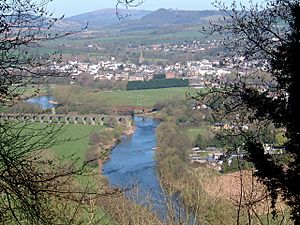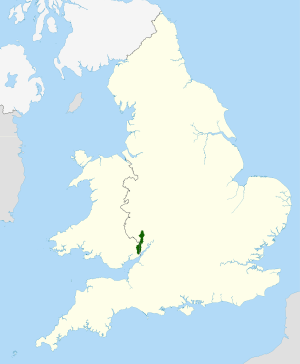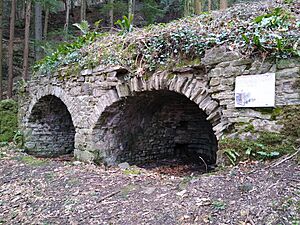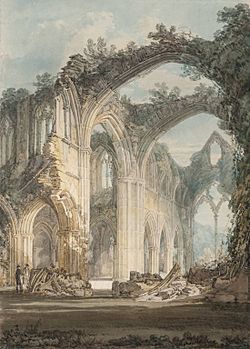Wye Valley facts for kids

The Wye Valley (Welsh: Dyffryn Gwy) is a beautiful valley found in both Wales and England. The River Wye (Welsh: Afon Gwy) is a very long river, actually the fourth-longest in the whole United Kingdom!
The river starts high up in the Cambrian Mountains. It flows down through towns like Rhayader, Builth Wells, and Hay-on-Wye. Then it reaches the England-Wales border and gets wider as it passes through Hereford. Further down, the valley winds past Ross-on-Wye and Monmouth. Here, the river forms the border between England and Wales. Finally, it reaches the Severn Estuary near Chepstow. This lower part of the valley is famous for its limestone gorges and thick forests. This amazing scenery helped the Wye Valley become one of the first places in Britain to attract tourists.
The lower part of the valley is a special protected area called the Wye Valley National Landscape. It's also known as an Area of Outstanding Natural Beauty. This means it's recognized as an important landscape around the world. This special area covers about 326 square kilometers (126 square miles). It stretches along 72 kilometers (45 miles) of the river, from just south of Hereford to Chepstow. It includes parts of Gloucestershire, Herefordshire, and Monmouthshire. Besides its stunning views, the area is also important for its wildlife, old ruins, and history of industry.
Contents
How the Wye Valley Was Made
The different landscapes you see in the Wye Valley are because of the rocks underneath. Over a very long time, ice, and then the river and its smaller streams, shaped the land.
Near Hereford, the rocks around the village of Woolhope are mostly Silurian limestones, shales, and sandstones. South of this, the land in Herefordshire has red mudstones and sandstones. These make the soil redder. These rocks are softer than the limestones. So, the river created more bends (called meanders), a wider flat area (a floodplain), and a gentler, rolling landscape. Around Symonds Yat, you can see where limestones and red sandstones meet. This creates a mix of hills and flat areas, plus impressive river cliffs from the river's bends.
The lower Wye Valley was formed as the river cut through layers of rock. These rocks tilt towards the Forest of Dean. The river has carved a deep gorge with big cliffs. The steepest parts of the Wye gorge are cut through Carboniferous Limestone. Here, the river, natural cracks in the rocks, and old quarries have created many tall, rocky faces. You can see these especially between Tintern and Chepstow.
There are also many interesting places underground. The area has many rock shelters and caves. Some famous ones include King Arthur's Cave near Symonds Yat and Slaughter Stream Cave near Berry Hill. At St Arvans, close to Chepstow, underground water has carved out long cave systems. One of these, Otter Hole, can only be reached when the tide is low. It's a very challenging cave for experienced explorers.
Amazing Wildlife
The Wye Valley is home to lots of different animals and plants. Places like Lancaut and Ban-y-Gor are nature reserves. They are part of the important Lower Wye Gorge SSSI and are within the Wye Valley National Landscape. The Wye Valley has rich habitats, including ancient forests, saltmarshes, and limestone cliffs.
The area has three sites that are super important for wildlife around the world. These are called Special Areas of Conservation (SACs). They include the River Wye (Afon Gwy), the Wye Valley and Forest of Dean Bat Sites, and the Wye Valley Woodlands. The valley is a great place for lesser horseshoe bats. It also has a growing number of peregrine falcons, goshawks, and ravens. You can find rare whitebeam trees, nightjar birds, and fish like the shad and twaite. The main Welsh groups of the small, colorful moth Oecophora bractella live here too.
In 2006, a colony of lesser horseshoe bats in the area reached a record number. About 890 bats were found living in a small stone barn!
Ancient History
People have lived in the Wye Valley for at least 12,000 years. Caves near Symonds Yat and Chepstow show that people lived here during the Palaeolithic (Old Stone Age). Finds from later stone ages, like the Neolithic (New Stone Age), have also been discovered. These finds tell us how early humans lived as nomadic hunters and traders.
Standing stones at Huntsham, Staunton, and Trellech date back to the Bronze Age. Later, during the Iron Age, forts were built on hilltops along the lower Wye Valley. These forts were well-protected settlements. They likely marked the edges of different tribal areas before the Romans arrived.
Watling Street, an old Roman road, passed through Roman towns like Ariconium (north of modern Ross-on-Wye) and Blestium (Monmouth). Other small Roman settlements are also known. The first signs of iron and coal mining in the valley are from the Roman period. Iron working happened in places like Monmouth and Trellech. The medieval towns of Goodrich and Chepstow, at each end of the Wye Gorge, might have started around this time.
Following the River Wye closely, Offa's Dyke was built in the 8th century. King Offa built it to mark the border between England and Wales. Today, it's the longest ancient monument in Britain. The Offa's Dyke Path is a long walking trail that follows this route on the English side. The Wye Valley Walk follows the Welsh side.
Castles and Monks
When the Normans took over the region in the 11th century, they quickly built big castles. Chepstow and Monmouth castles were built to protect their new land. Smaller castles were also built at St Briavels, Ruardean, Goodrich, and Wilton Castle.
Tintern Abbey was started in 1131 by Cistercian monks. It was mostly rebuilt in the 13th century. It is the best-preserved medieval abbey in Wales. It's a fantastic example of Gothic architecture.
Many of the smaller villages in the area probably began in the Middle Ages. Much of this growth was linked to the early iron industry. The medieval iron industry used a lot of charcoal. So, many woodlands were managed by coppicing (cutting trees to regrow) for this purpose. Trellech was one of the largest communities in Wales during this time.
The Rise of Industry
People have made iron in the Wye Valley since Roman times. They used the nearby timber, good quality iron ore, and lots of charcoal from the Forest of Dean. The river helped transport raw materials and finished products. When blast furnaces were invented in the 16th century, the river's smaller streams were used for water power.
The first brass made in Britain was created at Tintern in 1566. Then, wire-making started. Water mills for wire-making were built on all the smaller rivers flowing into the lower Wye. For the next 400 years, the area was full of the noise and smoke of heavy industry. Many new industries started here. For example, Whitebrook became known for paper milling when wallpaper became popular. At Redbrook, copper works began by 1691. A century later, the village became a major center for making tinplate. This industry lasted until the 1960s. It was famous for making the thinnest, highest quality tinplate in the world. The Lydbrook valley was also a busy place for metal industries, like making telegraph cables.
The valley woodlands were carefully managed. They grew mature trees for shipbuilding or were coppiced for charcoal. They also provided bark for tanning leather. The industries in the valley used a huge amount of timber. For example, a 150-ton ship needed 3,000 wagonloads of timber to build. In 1824, 13 ships were launched at Brockweir alone!
The river was the main support for the region's economy. It was an important way to transport goods, trade, and communicate. In medieval times, salmon weirs (traps) made it hard to travel freely on the river. But the Wye Navigation Act in 1662 helped improve the river for transport. By 1727, shallow boats could go upstream past Hereford. A big shipbuilding industry grew in Monmouth, Llandogo, Brockweir, and Chepstow. However, by 1835, people said the Wye "can scarcely be considered a commercial highway" above Monmouth. By the 1880s, Brockweir bridge was the highest point boats could easily reach.
As the 19th century went on, the valley's industries slowly declined. The woodlands were managed less because there wasn't as much demand for their products.
The Start of British Tourism
The Wye Valley saw the very beginning of British tourism in the 18th century. People started to appreciate the area's amazing beauty around the early 1700s. John Kyrle created the 'Prospect' viewpoint at Ross-on-Wye, and the poet Alexander Pope later wrote about it.
In 1745, John Egerton began taking friends on boat trips down the valley from Ross. The area became more widely known after the poet Thomas Gray wrote about it. Even more important was the book Observations on the River Wye by Reverend William Gilpin, published in 1782. This was the first illustrated tour guide in Britain. It helped travelers find and enjoy the most "Picturesque" (beautiful like a painting) parts of the countryside. Regular boat trips started from Ross, with the journey to Chepstow taking two days.
Some of the most famous poets, writers, and artists of the time visited the great sights of Goodrich, Tintern, and Chepstow. These included Coleridge, Thackeray, and Turner. Wordsworth was also captivated by the area. He wrote his famous poem Lines written a few miles above Tintern Abbey in 1798. In 1811, the popular 'peasant poet' Robert Bloomfield wrote 'The Banks of Wye; a Poem in Four Books'. This poem described a trip he took with friends down the River Wye in 1807.
The Wye Valley was one of Britain's first great landscapes to be 'discovered' by tourists. Its special charm was its river scenery. Many guidebooks, pictures, and paintings made sure that visitors kept coming. Special viewpoints were built, like the Kymin above Monmouth. It has a round house that gives amazing views over the town. Another highlight for travelers was the cliff climb and walks at Piercefield. However, most of the truly 'Picturesque' scenes were drawn from the river level. The shimmering water was the foreground for the forests, cliffs, and castle and abbey ruins behind.
Getting Around the Valley

In 1813, the Monmouth Tramroad connected Coalway (near Coleford), Redbrook, and Monmouth. This was the world's first railway that was allowed to charge passengers for rides.
The main Wye Valley Railway line between Chepstow, Monmouth, and Ross opened much later, in 1876. This made the valley easier to reach and even more popular for tourists. In the early 1900s, huge crowds (up to 1300 people) would travel on special trains to see Tintern Abbey on the night of the harvest moon. The line closed to passengers in 1959. However, some parts of it are now used as paths for walking and horse riding. Today, you can find main train stations in Hereford and Chepstow.
The roads in the lower Wye valley didn't develop much during the industrial boom. This changed when a series of Turnpike trusts (companies that built and maintained roads, charging tolls) were set up in the 18th century. The current Wye Valley road, the A466, was first built in 1828. The area became much easier to reach by road from other parts of the country with the building of the M50 (between the M5 and Ross-on-Wye). The opening of the Severn Bridge (now part of the M48) in 1966 also made a big difference.
Protecting the Landscape
The Wye Valley Area of Outstanding Natural Beauty (AONB) was officially recognized in 1971. This recognition shows how important it is to protect the area's special qualities for everyone, now and in the future.
Managing the area is quite complex. It's the only protected landscape that crosses the border between England and Wales. The counties of Herefordshire, Monmouthshire, and Gloucestershire are all in different government regions. To help coordinate conservation across these borders, there's a special AONB unit and a Joint Advisory Committee. A Management Plan for the AONB works with many partners to protect and improve its beauty for future generations.
The area is mostly rural, meaning it's countryside. Many people earn a living from tourism, farming, or forestry. Ross-on-Wye is the only town actually inside the National Landscape. But Hereford, Monmouth, Coleford, and Chepstow are just outside its borders.
In 2023, all AONBs in the UK were renamed National Landscapes. They still keep their original designation as Areas of Outstanding Natural Beauty.
The part of the Wye that has tides (below Bigsweir) is managed by the Gloucester Harbour Trustees.





